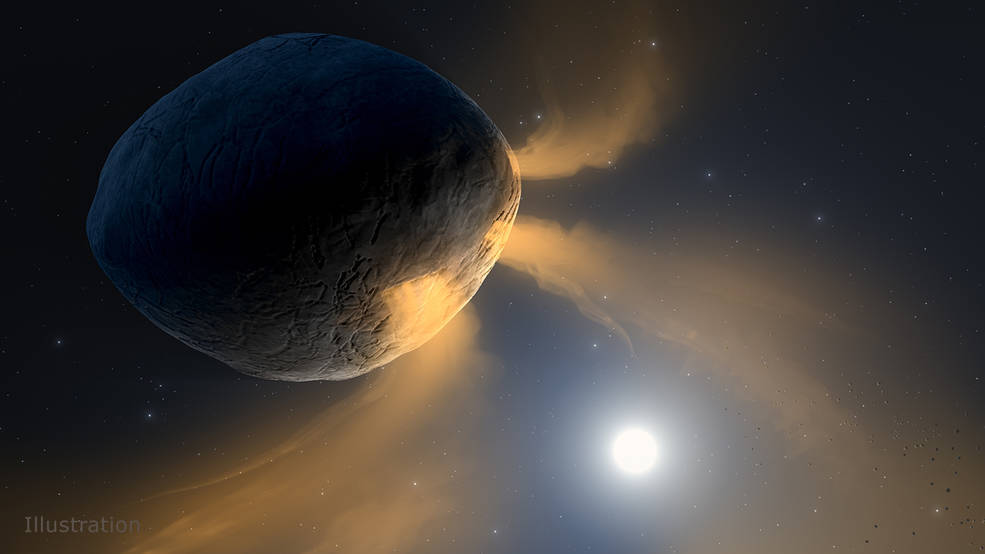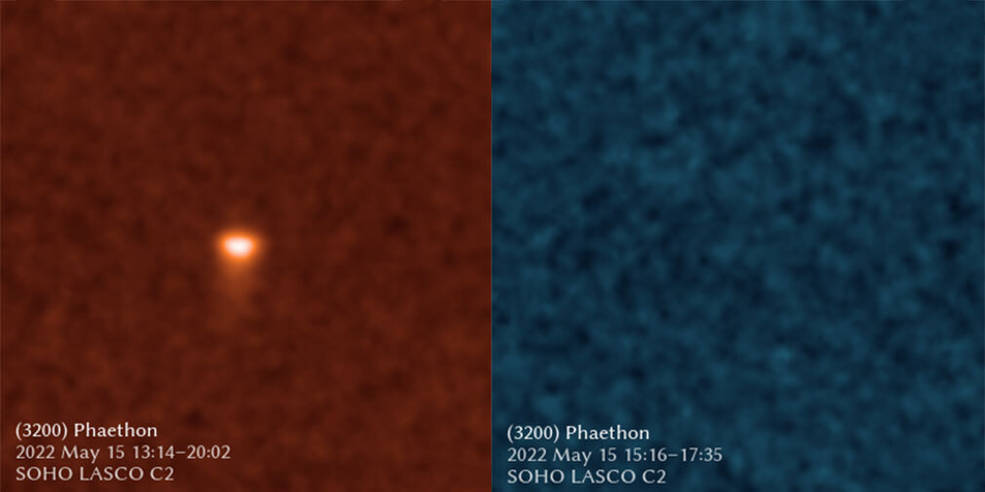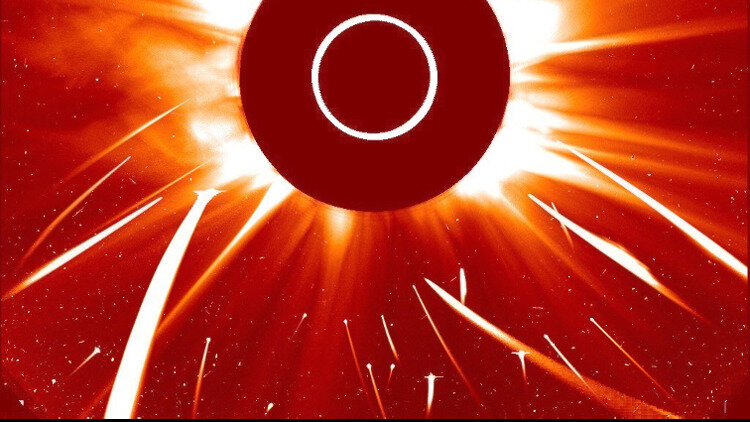27.04.2023
A weird asteroid has just gotten a little weirder.
We have known for a while that asteroid 3200 Phaethon acts like a comet. It brightens and forms a tail when it’s near the Sun, and it is the source of the annual Geminid meteor shower, even though comets are responsible for most meteor showers. Scientists had blamed Phaethon’s comet-like behavior on dust escaping from the asteroid as it’s scorched by the Sun. However, a new study using two NASA solar observatories reveals that Phaethon’s tail is not dusty at all but is actually made of sodium gas.
“Our analysis shows that Phaethon’s comet-like activity cannot be explained by any kind of dust,” said California Institute of Technology PhD student Qicheng Zhang, who is the lead author of a paper published in the Planetary Science Journal reporting the results.

Asteroids, which are mostly rocky, do not usually form tails when they approach the Sun. Comets, however, are a mix of ice and rock, and typically do form tails as the Sun vaporizes their ice, blasting material off their surfaces and leaving a trail along their orbits. When Earth passes through a debris trail, those cometary bits burn up in our atmosphere and produce a swarm of shooting stars – a meteor shower.
After astronomers discovered Phaethon in 1983, they realized that the asteroid’s orbit matched that of the Geminid meteors. This pointed to Phaethon as the source of the annual meteor shower, even though Phaethon was an asteroid and not a comet.
In 2009, NASA’s Solar Terrestrial Relations Observatory (STEREO) spotted a short tail extending from Phaethon as the asteroid reached its closest point to the Sun (or “perihelion”) along its 524-day orbit. Regular telescopes hadn’t seen the tail before because it only forms when Phaethon is too close to the Sun to observe, except with solar observatories. STEREO also saw Phaethon’s tail develop on later solar approaches in 2012 and 2016. The tail’s appearance supported the idea that dust was escaping the asteroid’s surface when heated by the Sun.
However, in 2018, another solar mission imaged part of the Geminid debris trail and found a surprise. Observations from NASA’s Parker Solar Probe showed that the trail contained far more material than Phaethon could possibly shed during its close approaches to the Sun.
Zhang’s team wondered whether something else, other than dust, was behind Phaethon’s comet-like behavior. “Comets often glow brilliantly by sodium emission when very near the Sun, so we suspected sodium could likewise serve a key role in Phaethon’s brightening,” Zhang said.
An earlier study, based on models and lab tests, suggested that the Sun’s intense heat during Phaethon’s close solar approaches could indeed vaporize sodium within the asteroid and drive comet-like activity.
Hoping to find out what the tail is really made of, Zhang looked for it again during Phaethon’s latest perihelion in 2022. He used the Solar and Heliospheric Observatory(SOHO) spacecraft — a joint mission between NASA and the European Space Agency (ESA) – which has color filters that can detect sodium and dust. Zhang’s team also searched archival images from STEREO and SOHO, finding the tail during 18 of Phaethon’s close solar approaches between 1997 and 2022.
In SOHO’s observations, the asteroid’s tail appeared bright in the filter that detects sodium, but it did not appear in the filter that detects dust. In addition, the shape of the tail and the way it brightened as Phaethon passed the Sun matched exactly what scientists would expect if it were made of sodium, but not if it were made of dust.
This evidence indicates that Phaethon’s tail is made of sodium, not dust.
“Not only do we have a really cool result that kind of upends 14 years of thinking about a well-scrutinized object,” said team member Karl Battams of the Naval Research Laboratory, “but we also did this using data from two heliophysics spacecraft – SOHO and STEREO – that were not at all intended to study phenomena like this.”

Zhang and his colleagues now wonder whether some comets discovered by SOHO – and by citizen scientists studying SOHO images as part of the Sungrazer Project – are not comets at all.
“A lot of those other sunskirting ‘comets’ may also not be ‘comets’ in the usual, icy body sense, but may instead be rocky asteroids like Phaethon heated up by the Sun,” Zhang explained.
Still, one important question remains: If Phaethon doesn’t shed much dust, how does the asteroid supply the material for the Geminid meteor shower we see each December?
Zhang’s team suspects that some sort of disruptive event a few thousand years ago – perhaps a piece of the asteroid breaking apart under the stresses of Phaethon’s rotation – caused Phaethon to eject the billion tons of material estimated to make up the Geminid debris stream. But what that event was remains a mystery.
More answers may come from an upcoming Japan Aerospace Exploration Agency (JAXA) mission called DESTINY+ (short for Demonstration and Experiment of Space Technology for Interplanetary voyage Phaethon fLyby and dUst Science). Later this decade, the DESTINY+ spacecraft is expected to fly past Phaethon, imaging its rocky surface and studying any dust that might exist around this enigmatic asteroid.
by Vanessa Thomas
NASA’s Goddard Space Flight Center, Greenbelt, Md.
Quelle: NASA
+++
SOHO chases asteroid's tail
The ESA/NASA SOHO observatory has overturned 14 years of thinking about the strange Sun-skirting ‘rock comet’ known as Phaethon that could reopen the mystery of how the Geminid meteor shower was born.
Every December, the Geminid meteor shower lights up Earth's skies as our planet plunges through a vast cloud of dust in space. For years, the parent body of this meteor shower was unknown. Most of the annual meteor showers are associated with comets, which leave clouds of dust trailing behind them in the form of their tails. But the Geminids were different: no parent body was obvious.
When Phaethon was discovered in 1983 by the joint US/UK/Netherlands IRAS satellite, astronomers thought the mystery was solved. This small 5.8 km-wide object circled the Sun in an orbit very similar to that of the Geminid dust cloud, providing near-certain proof that Phaethon was the meteor shower's parent body even though Phaethon was an asteroid not a comet.

Each orbit of Phaethon, lasting 524 days, consists of an unusually close approach to the Sun. At a closest approach (perihelion) distance of 21 million km, Phaethon is hidden from observatories on Earth by the blinding glare of the Sun. Therefore, solar observatories provide the only way to capture vital images to study the extreme activity of the asteroid at perihelion.
Since 2009, the NASA Solar Terrestrial Relations Observatory (STEREO) has observed a sudden brightening of the asteroid a few hours after perihelion. At this close approach, Phaethon also sports a tail, hundreds of kilometres in length, facing away from the Sun. This activity was originally thought to be caused by the release of small dust grains from the cracking of the asteroid’s surface as it passes the Sun. This led to Phaethon being dubbed a ‘rock comet’.
Now, new observations from SOHO recorded in May 2022 have shown for the first time that, contrary to 14 years of previous thought, the emission of sodium atoms is likely responsible for this activity.

As part of a special observing plan devised by Qicheng Zhang and Karl Battams, long-exposure, filtered images were taken by SOHO’s Large Angle and Spectrometric Coronagraph (LASCO) telescope. Phaethon and its tail are absent from images taken with LASCO’s blue filter, which can detect dust. But, it is bright in the sodium-sensitive orange filter, offering compelling evidence that sodium emission is occurring. The emission is caused by fluorescence, when sodium atoms get excited by the Sun and glow orange, similar to a street lamp.
“Our unique observing plan found the mysterious asteroid Phaethon for the first time in SOHO data,” says PhD student Qicheng Zhang, who led the study. “The distinctive filters of the 27-year-old LASCO camera were used in a special interruption to the regular observing schedule to uncover these hidden secrets. By digging in the treasure chest of SOHO, we showed that Phaethon is visible in LASCO images from 18 different orbits back to 1997.”

Phaethon is not the only object near the Sun to be releasing sodium. The planet Mercury also exhibits a bright sodium tail that peaks around two weeks after perihelion – something that the joint ESA/JAXA BepiColombo mission will investigate once in orbit around Mercury. Observations of Mercury’s sodium tail from the STEREO H1-1 heliospheric imager were used as a calibration standard, like a standard lamp, to study this emission from Phaethon to support Zhang’s theory.
SOHO has observed hundreds of tiny Sun-skirting objects that are classified as comets – icy bodies which appear to brighten when very close to the Sun. These can be hard to distinguish from asteroids like Phaethon which shine temporarily. However, the sodium identified in this study has opened the possibility that perhaps the so-called comets discovered by SOHO are more like rocky asteroids similar to Phaethon.
This study shines more light on the events which could have formed the Geminid meteoroids, which range in size from sand-grains to pea-sized. Sodium activity on the surface is not enough to lift these particles and contribute to the stream. Instead, an unobserved and unknown disruption of Phaethon, perhaps over two thousand years ago, is assumed to have created the shower.
The fresh layers of volatile sodium which contribute to the brightening observed today suggest that another mass-loss event may have resurfaced Phaethon more recently, perhaps less than 1000 years ago. Therefore, the exact origin of the Geminids meteoroids may be better understood by studying Phaethon.

There is great interest in Phaethon due to its distinctive activity and mysterious history, which make it an essential and intriguing source of up-close future study. Hence, JAXA is preparing to send a flyby mission called DESTINY+ to image the surface of Phaethon in 2028 and uncover more about its history.
In addition to future missions, citizen scientists can play their part in revealing new discoveries using SOHO. Over 4500 Sun-skirting objects have been identified in SOHO images, the majority with the help of the Sungrazer Project. Citizen scientist ‘comet hunters’ can sift through SOHO and STEREO data to identify new objects.
Karl Battams, principal investigator of both LASCO and the Sungrazer project, explains, “SOHO is the most prominent comet hunter in history, with a huge catalogue of discoveries still awaiting detailed analysis. Both SOHO and STEREO are uniquely placed to be able to routinely observe objects extremely close to the Sun. The future of asteroid and comet studies is bright thanks to these and future encounter missions that will help us uncover more about these dynamic objects.”
“Since its launch in 1995, SOHO and its instruments continue to deliver exciting science, using the mission in different ways to study asteroids and comets in addition to its primary target, the Sun,” adds Bernhard Fleck, ESA’s SOHO project scientist.
Quelle: ESA


